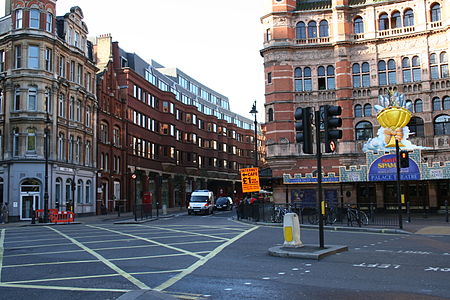Cambridge Circus, London
Road junctions in LondonStreets in the City of WestminsterStreets in the London Borough of CamdenUse British English from June 2015

Cambridge Circus is the partly pedestrianised intersection where Shaftesbury Avenue crosses Charing Cross Road on the eastern edge of Soho, central London. Side-streets Earlham, West, Romilly and Moor streets also converge at this point. It is halfway between Tottenham Court Road station, Oxford Street (at St Giles Circus) and the centre of Leicester Square, which is southwest of Charing Cross Road via Cranborne Street. The Circus is fronted by listed Georgian and Victorian buildings. Of these, the Palace Theatre has the widest façade; three bars and three fast food outlets, unusually, occupy the ground floors of the others.
Excerpt from the Wikipedia article Cambridge Circus, London (License: CC BY-SA 3.0, Authors, Images).Cambridge Circus, London
Charing Cross Road, London Bloomsbury (London Borough of Camden)
Geographical coordinates (GPS) Address Nearby Places Show on map
Geographical coordinates (GPS)
| Latitude | Longitude |
|---|---|
| N 51.513295 ° | E -0.129164 ° |
Address
Cambridge Circus
Charing Cross Road
WC2H 8AA London, Bloomsbury (London Borough of Camden)
England, United Kingdom
Open on Google Maps







